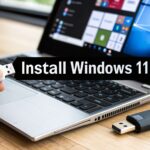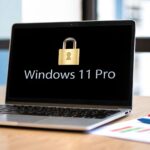Australia
In our modern work culture, the line between the office and home has blurred. Secure access to a primary workstation is no longer a luxury but a fundamental professional requirement. This is where a tool like Remote Desktop becomes essential, allowing you to connect to your main computer from anywhere.
The Professional Advantage of Remote Access
Thinking of Remote Desktop as just another feature misses its strategic value. It is a powerful tool that offers significant advantages for professionals and businesses. The most immediate benefit is unmatched flexibility. Imagine carrying your powerful office desktop in your pocket, ready to be accessed from a lightweight laptop at a client’s office or a tablet in a coffee shop. This capability ensures you are never disconnected from your most important files and applications.
This flexibility directly translates into productivity gains. Consider a graphic designer who needs to render a complex 3D model. Instead of being tied to a bulky, high-performance workstation, they can use a simple tablet to control the rendering process remotely. This means they can start a demanding task at the office and monitor its progress from home without interruption. It is this seamless workflow that defines modern efficiency.
For small businesses and freelancers, the cost savings are substantial. Instead of purchasing multiple high-spec computers for different locations, you can invest in one powerful machine and access it from more affordable devices. This reduces hardware expenditure and simplifies software management. Even with the growth of cloud solutions, many IT professionals on platforms like Reddit agree that Windows RDS remains highly relevant for its control and security. As a reliable source for essential digital tools, we at DigitalHubKey see this feature as a cornerstone of professional computing.
System Prerequisites for a Smooth Setup
Before you begin, it is important to confirm your system meets a few key requirements. This simple check prevents frustration later and ensures a smooth setup. The most critical prerequisite is your version of Windows. The ability to host a remote session is a key benefit of Windows 11 Pro remote access. If you are using Windows 11 Home, you can connect to another computer, but you cannot host a connection on your own machine. Users with the Home edition will need to upgrade to Windows 11 Pro to enable incoming connections.
Once you have confirmed you have the Pro edition, make sure you have the following prepared:
- Your Computer’s Name: This is the unique identifier you will use to connect. You can find it by going to Settings > System > About.
- Power and Connectivity: The host computer must be turned on, awake, and connected to the internet.
- A Password-Protected Account: For security, the user account you plan to log in with must have a password.
Understanding the differences between the Windows editions is crucial for remote work.
| Feature | Windows 11 Home | Windows 11 Pro |
|---|---|---|
| Host a Remote Desktop Session | Not Supported | Supported |
| Connect to Another PC (Client) | Supported | Supported |
| Network Level Authentication (NLA) | N/A (Cannot Host) | Supported |
| BitLocker Device Encryption | Limited | Full Support |
Note: This table highlights that while any Windows 11 edition can connect to another computer, only the Pro edition can act as a host for incoming Remote Desktop connections.
A Step-by-Step Guide to Enabling Remote Desktop
With the prerequisites confirmed, you are ready to activate the feature. The process is straightforward and only takes a few minutes. These steps follow the standard procedure outlined by Microsoft for enabling the feature, ensuring a reliable setup. Here is how to enable remote desktop windows 11 on your machine.
- Open Windows Settings: The quickest way to get there is by pressing the Windows key + I on your keyboard simultaneously.
- Navigate to the Remote Desktop Menu: In the Settings window, select System from the left-hand sidebar. Scroll down and click on Remote Desktop.
- Activate Remote Desktop: You will see a toggle switch for Remote Desktop. Click it to turn it on. A confirmation box will appear asking if you are sure you want to enable it. Click Confirm to proceed.
- Manage User Access: By default, administrators on the computer automatically have access. If you need to grant access to a standard user account, click on Remote Desktop users. In the new window, click Add and enter the username of the person you want to grant access to.
- Verify and Note Your PC Name: On the main Remote Desktop settings screen, double-check that the feature is listed as “On.” Just below the toggle, you will see your PC name listed. Write this down, as you will need it to connect from another device.
Ensuring you have the right OS is the first step for powerful features like this. You can explore various operating systems we offer to find the one that best fits your professional needs.
Configuring Security for a Safe Connection
Enabling remote access also means taking responsibility for its security. A secure remote desktop connection relies on several layers of protection that work together to keep your data safe. Fortunately, Windows 11 Pro has robust, built-in tools to help you manage this.
First is Network Level Authentication (NLA). Think of NLA as a security guard who checks your ID before you even reach the front door. It requires users to authenticate themselves before a full remote session is established, which helps protect against malicious connection attempts. This option is enabled by default and should always be kept on.
Next, consider the Windows Defender Firewall. When you enable Remote Desktop, Windows automatically creates a firewall rule to allow the connection. While you typically do not need to change anything, it is good practice to know where this is. You can verify that “Remote Desktop” is listed as an allowed app in your firewall settings, giving you peace of mind.
The most fundamental security measure is your password. Your user account password is the primary key to your remote system. Ensure it is strong, unique, and not used anywhere else. Avoid simple passwords and consider using a combination of letters, numbers, and symbols. This single habit dramatically improves your security posture.
Finally, be cautious when connecting over public Wi-Fi networks, such as those in cafes or airports. For the highest level of security in these situations, use a Virtual Private Network (VPN). A VPN encrypts your internet traffic, creating a secure tunnel between your client device and your remote computer. For an added layer of protection against a wide range of online threats, consider using robust security software like the Norton 360 Premium suite we provide.
Connecting to Your Remote Computer
Once you have enabled and secured Remote Desktop on your host machine, the final step is to connect to it from another device. This client device can be another Windows PC, a Mac, or even a mobile phone.
On a Windows client computer, search for and open the “Remote Desktop Connection” application from the Start Menu. In the window that appears, you will see a field for “Computer.” This is where you enter the PC name of your host machine that you noted down earlier. Click Connect.
You will then be prompted to enter your credentials. Use the username and password for the account on your host computer. After successful authentication, your host computer’s desktop will appear in a window, giving you full control as if you were sitting right in front of it.
One of the greatest strengths of this feature is its cross-platform flexibility. Microsoft provides official Remote Desktop client apps for macOS, iOS, and Android, allowing you to connect from virtually any device. This guide on how to set up remote desktop empowers you to work from anywhere. Once connected, you will have full access to your files and applications, including essential software suites like the Microsoft Office 2021 package available in our store.







